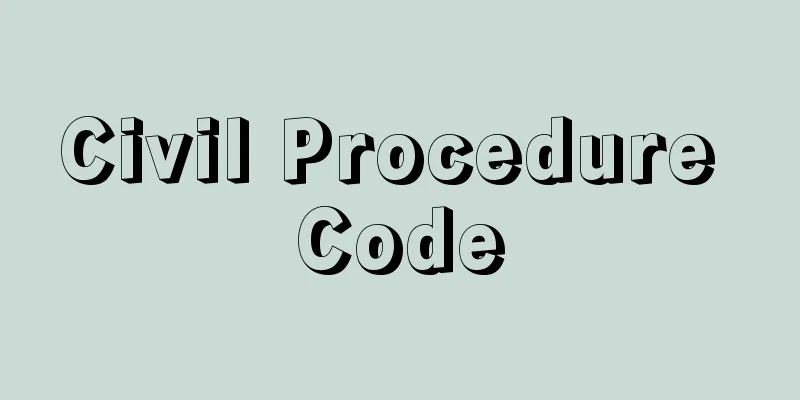Civil Procedure Code

|
It has both substantive and formal meanings; in the former, it refers collectively to all laws related to civil litigation, such as civil litigation procedures and legal norms that govern civil litigation relationships, while in the latter, it refers to the Civil Procedure Code as a written law. Civil litigation is a legal system that guarantees the realization of rights under private substantive law, and therefore in order to ensure a perfect legal order, it is necessary to aim for universal fairness rather than relative expediency. Although the content of the provisions varies slightly from country to country, generally, most laws concerning civil litigation are mandatory laws, and the majority of them are formal norms that regulate the procedures. In addition, provisions concerning matters related to the subjects of litigation, such as the composition and power of the courts, and the capacity and representation of the parties, as well as the litigation relationships between each subject are also included. In Japan, the "Code of Civil Procedure" (Law No. 29 of Meiji 23) was enacted in 1890 as a written law. This code was drafted by German Hermann Techow (1838-1909) based on the German Code of Civil Procedure of 1877. Soon after, the code was revised, and Chapters 1 to 5 were completely rewritten in the 1926 (Taisho 15) revision (effective October 1, 1929), and several other revisions and abolitions were made thereafter. After World War II, some revisions were made under the influence of Anglo-American law, and furthermore, with the enactment of the "Civil Execution Act" in 1979 (Showa 54), most of the compulsory execution provisions in the former Chapter 6 were deleted, and with the enactment of the "Civil Preservation Act" in 1989 (Heisei 1), the provisions on provisional attachment and provisional disposition that were provided in the former Chapter 6 were deleted. [Takeyoshi Uchida and Tetsuo Kato, May 19, 2016] Current Civil Procedure CodeThe Civil Procedure Code, enacted during the Meiji period, has been revised several times, but it still had problems such as being difficult for the public to understand, not being suited to modern, complex civil disputes, and procedures being too time-consuming and expensive. For this reason, a new "Civil Procedure Code" (Act No. 109 of 1996) was enacted (effective January 1, 1998), which revised the provisions to fit modern society and also changed the text to modern hiragana. In the current Civil Procedure Code, the procedures for collecting evidence (Articles 164 et seq.) have been improved from the viewpoint of "enhancing oral arguments" and "facilitating proceedings," and the procedures for collecting evidence have been expanded, such as by expanding the scope of documents that are required to be submitted. In addition, the small claims procedure (Articles 368 et seq.) has been established to reduce the economic and time burden on the parties in lawsuits seeking payment of money with a value of 600,000 yen or less, and the appeal acceptance system (Article 318) has been established to reduce the burden on the Supreme Court and to enhance the proceedings of important cases. The Code is a large code with over 400 articles, consisting of Part 1 General Provisions, Part 2 First Instance Litigation Procedures, Part 3 Appeals, Part 4 Retrials, Part 5 Special Provisions on Bill Actions and Check Actions, Part 6 Special Provisions on Small Claims Actions, Part 7 Demand Procedures, Part 8 Stay of Execution, and Supplementary Provisions, and is one of the so-called Six Codes. In addition, the parts of the old Civil Procedure Code that corresponded to the new law were deleted in the 1996 amendment. The public notice and demand procedures that existed in the old law were moved to Part 3 of the "Non-Contentious Cases Procedure Law" (Law No. 14 of 1898) in 2004 (and further moved to Part 4 of the new "Non-Contentious Cases Procedure Law" Law No. 51 of 2011 in 2013), and arbitration procedures are now regulated by the "Arbitration Law" (Law No. 138 of 2003). In the practical sense, civil procedure law includes, in addition to the above, the main laws such as the Court Law, the Law on Civil Litigation Costs, the Civil Execution Law, the Civil Preservation Law, the Attorney Law, the Personal Affairs Litigation Law, the Bankruptcy Law, the Civil Rehabilitation Law, and the Civil Procedure Rules. In addition to being independent laws, there are also provisions related to civil procedure law in the Civil Code, Commercial Code, etc. [Takeyoshi Uchida and Tetsuo Kato, May 19, 2016] [Reference items] | | | | | | |Source: Shogakukan Encyclopedia Nipponica About Encyclopedia Nipponica Information | Legend |
|
実質的意義と形式的意義とがあり、前者においては、民事訴訟手続ならびに民事訴訟関係を規律する法規範など民事訴訟に関するいっさいの法規を総称し、後者においては、成文法としての民事訴訟法典をさす。 民事訴訟は、私法実体法上の権利の具体化を担保する法律制度であるから、法律秩序の万全を期するために相対的便宜よりも普遍的公平を旨とする必要がある。そこで国によって規定内容が若干異なるけれども、一般的に民事訴訟に関する法規は、大部分が強行法であり、かつ手続を規律する形式的規範がその主要な部分を占めている。そのほか、裁判所の構成・権限、当事者の能力・代理など、訴訟主体に関する事項および各主体間の訴訟関係に関する規定も、そのなかに包括されている。 日本においては、この成文法として1890年に「民事訴訟法」(明治23年法律第29号)が制定された。この法典は、ドイツ人テヒョーHermann Techow(1838―1909)が1877年のドイツ民事訴訟法をもとに起草したものであった。まもなく改正の動きが始まり、その第1編ないし第5編が1926年(大正15)の改正によって全面的に書き改められ(1929年10月1日施行)、その後もいくつかの改廃がなされた。第二次世界大戦後は、英米法の影響を受けて若干の改正が加えられ、さらに1979年(昭和54)「民事執行法」の制定に伴い、旧第6編強制執行の大部分が、また1989年(平成1)「民事保全法」の制定に伴い、旧第6編に規定されていた仮差押え・仮処分の部分が削除された。 [内田武吉・加藤哲夫 2016年5月19日] 現行民事訴訟法明治時代に制定された民事訴訟法は、何度か改正されたものの、国民にわかりにくい、現代の複雑な民事紛争に適合していない、手続に費用と時間がかかりすぎるなどの問題があった。そのため1996年(平成8)に新たな「民事訴訟法」(平成8年法律第109号)が制定され(1998年1月1日施行)、現代の社会に適合するよう規定が整備されるとともに条文も平仮名現代語表記となった。 現行民事訴訟法では、「口頭弁論の充実」「審理の促進」の観点から争点証拠整理手続(同法164条以下)についてその充実が図られ、文書提出義務の対象文書の拡大など証拠収集手続が拡充された。また、訴訟の目的の価額が60万円以下の金銭の支払の請求を目的とする訴えについて当事者の経済的・時間的負担を軽減した少額訴訟手続(同法368条以下)や、最高裁判所の負担を軽減し重要な事件の審理を充実させるため最高裁への上告を制限した上告受理制度(同法318条)などが創設された。同法は、第1編総則、第2編第一審の訴訟手続、第3編上訴、第4編再審、第5編手形訴訟及び小切手訴訟に関する特則、第6編少額訴訟に関する特則、第7編督促手続、第8編執行停止、附則からなっており、400か条余を擁する大型法典で、いわゆる六法の一つである。 なお1996年の改正で、旧民事訴訟法の新法に相当する部分は削除された。旧法に存在した公示催告手続は2004年に「非訟事件手続法」(明治31年法律第14号)第3編に移され(さらに2013年、新「非訟事件手続法」平成23年法律第51号の第4編に移動)、また仲裁手続は「仲裁法」(平成15年法律第138号)により規定されることとなった。 実質的意義における民事訴訟法には、前記のほかおもなものとして、裁判所法、民事訴訟費用等に関する法律、民事執行法、民事保全法、弁護士法、人事訴訟法、破産法、民事再生法などの法律や民事訴訟規則などが含まれる。また独立の法令としてのほかに、民法、商法などのうちにも民事訴訟法に関する規定がある。 [内田武吉・加藤哲夫 2016年5月19日] [参照項目] | | | | | | |出典 小学館 日本大百科全書(ニッポニカ)日本大百科全書(ニッポニカ)について 情報 | 凡例 |
<<: Ming Shi Lu (Records of the Ming Dynasty)
Recommend
The Thirty-Nine Articles of Faith
The Articles of Faith of the Church of England. Th...
Ctesiphon - Ctesiphon (English spelling)
The remains of an ancient city in Mesopotamia. It...
Nationalist Party - Nationalist Party
A Philippine political party. It is a successor to...
Yoriharu Water - Raishunsui
A Confucian scholar of the late Edo period. Born ...
Functional harmony - Yesterday's music
A harmonic theory in Western music of the 18th and...
Middle America
...The area is about 42 million km2, of which abo...
Garden Suburb
…Housing construction, which was initially planne...
Te Deum (English spelling) [Latin]
This hymn begins with the words "Te Deum laud...
Catastrophe theory - katastrofiron
…He became a member of the Academie des Sciences ...
Price Leader
...When there is an oligopolistic market structur...
Breaker (English spelling)Bräker, Ulrich
Born: December 22, 1735 in Nevis Died: September 1...
Buṭrus al‐Bustānī
1819‐83 An enlightened humanist nationalist who de...
First funeral - Ichijiso
...A burial method in which a body is temporarily...
Eclectic School
The eclectic school is a collective term for Conf...
Apoxyomenos - Apoxyomenos
…Scopas, a native of Paros, succeeded in expressi...


![Iwaki [town] - Iwaki](/upload/images/67caf45b42406.webp)






